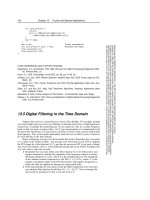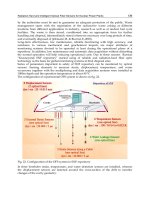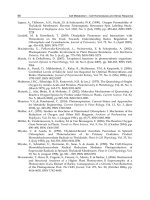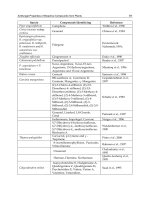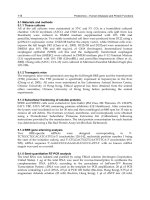Chapter 131. Diphtheria and Other Infections Caused by Corynebacteria and Related Species (Part 6) doc
Bạn đang xem bản rút gọn của tài liệu. Xem và tải ngay bản đầy đủ của tài liệu tại đây (46.18 KB, 5 trang )
Chapter 131. Diphtheria and Other Infections Caused by
Corynebacteria and Related Species
(Part 6)
Microbiology and Laboratory Diagnosis
These organisms are non-acid-fast, catalase-positive, aerobic or
facultatively anaerobic bacilli. Their colonial morphologies vary widely; some
species are small and α-hemolytic (similar to lactobacilli), whereas others form
large white colonies (similar to yeasts). Many nondiphtherial coryneforms require
special medium (e.g., Löffler's, Tinsdale's, or telluride medium) for growth.
Epidemiology
Humans are the natural reservoirs for several nondiphtherial coryneforms,
including C. xerosis, C. pseudodiphtheriticum, C. striatum, C. minutissimum, C.
jeikeium, C. urealyticum, and A. haemolyticum. Animal reservoirs are responsible
for carriage of A. pyogenes, C. ulcerans, and C. pseudotuberculosis. Soil is the
natural reservoir for R. equi.
C. pseudodiphtheriticum is part of the normal flora of the human pharynx
and skin. C. xerosis is found on the skin, nasopharynx, and conjunctiva; C. auris
in the external auditory canal; and C. striatum in the anterior nares and on the skin.
C. jeikeium and C. urealyticum are found in the axilla, groin, and perineum,
particularly in hospitalized patients. C. ulcerans and C. pseudotuberculosis
infections have been associated with the consumption of raw milk from infected
cattle.
Specific Nondiphtherial Coryneforms
C. ulcerans
This organism causes a diphtheria like illness and produces both diphtheria
toxin and a dermonecrotic toxin. C. ulcerans is a commensal in horses and cattle
and has been isolated from cow's milk. The organism causes exudative
pharyngitis, primarily during summer months, in rural areas, and among
individuals exposed to cattle. In contrast to diphtheria, C. ulcerans infection is
considered a zoonosis, and person-to-person transmission has not been firmly
established. Nevertheless, treatment with antitoxin and antibiotics should be
initiated when respiratory C. ulcerans is identified, and a contact investigation
(including throat cultures to determine the need for antimicrobial prophylaxis and
vaccination with the appropriate diphtheria toxoid–containing vaccine for
unimmunized human contacts) should be conducted. The organism grows on
Löffler's, Tinsdale's, and telluride media as well as blood agar. In addition to
exudative pharyngitis, cutaneous disease due to C. ulcerans has been reported.
C. ulcerans is susceptible to a wide panel of antibiotics. Erythromycin and
macrolides appear to be the first-line agents.
C. pseudotuberculosis (ovis)
Infections caused by C. pseudotuberculosis are rare and are reported almost
exclusively from Australia. C. pseudotuberculosis causes suppurative
granulomatous lymphadenitis and an eosinophilic pneumonia syndrome among
individuals who handle horses, cattle, goats, and deer or who drink unpasteurized
milk. The organism is an important veterinary pathogen, causing suppurative
lymphadenitis, abscesses, and pneumonia, but is rarely a human pathogen.
Successful treatment with erythromycin or tetracycline has been reported, with
surgery also performed when indicated.
C. jeikeium (Group JK)
After a 1976 survey of diseases caused by nondiphtherial corynebacteria,
CDC Group JK was recognized as an important opportunistic pathogen among
neutropenic patients and later emerged in HIV-infected patients as an AIDS-
associated opportunistic infection. This led to the organism's reclassification as a
separate species, C. jeikeium. The predominant syndrome associated with C.
jeikeium is sepsis, which can occur in conjunction with pneumonia, endocarditis,
meningitis, osteomyelitis, or epidural abscess. Risk factors for C. jeikeium
infection include hematologic malignancy, neutropenia from comorbid conditions,
prolonged hospitalization, exposure to multiple antibiotics, and skin disruption.
There is evidence that C. jeikeium is part of the normal flora of the inguinal,
axillary, genital, and perirectal areas in hospitalized patients.
Broad-spectrum antimicrobial therapy appears to select for colonization.
Originally described in the United States, C. jeikeium has also been reported in
Europe. The gram-positive coccobacilli, which slightly resemble streptococci,
grow as small, gray to white, glistening, nonhemolytic colonies on blood agar. C.
jeikeium lacks urease and nitrate reductase and does not ferment most
carbohydrates. It is resistant to most antibiotics tested except for vancomycin.
Effective therapy involves removal of the source of infection, be it a catheter, a
prosthetic joint, or a prosthetic valve. There have been efforts to prevent C.
jeikeium infection by use of antibacterial soap in the care of high risk patients in
intensive care settings.
C. urealyticum (Group D2)
Identified as a urease-positive nondiphtherial Corynebacterium in 1972, C.
urealyticum is an opportunistic cause of sepsis and urinary tract infection. This
organism appears to be the etiologic agent of a severe urinary tract syndrome
known as alkaline-encrusted cystitis: a chronic inflammatory bladder infection
associated with deposition of ammonium magnesium phosphate on the surface and
walls of ulcerating lesions in the bladder. In addition, C. urealyticum has been
associated with pneumonia, peritonitis, endocarditis, osteomyelitis, and wound
infection. It is similar to C. jeikeium in its resistance to most antibiotics except
vancomycin, which has been used successfully in the treatment of severe
infections.
C. minutissimum
Erythrasma is a cutaneous infection producing reddish-brown, macular,
scaly, pruritic intertriginous patches. The dermatologic presentation under the
Wood's lamp is of coral-red fluorescence. C. minutissimum appears to be a
common cause of erythrasma, although there is evidence for a polymicrobial
etiology in certain settings. In addition, this fluorescent microbe has been
associated with bacteremia in patients with hematologic malignancy. Erythrasma
responds to topical erythromycin, clarithromycin, clindamycin, or fusidic acid,
although more severe infections may require oral macrolide therapy.
